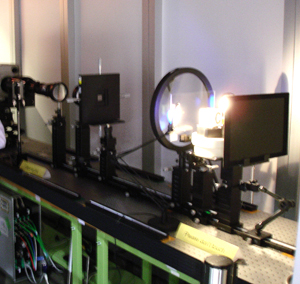NAB 2009: Holography Update

NEW YORK: There have been many comments on what was posted previously regarding the electronic holography shown at NAB 2009 by Japan’s National Institute of Information and Communications Technologies. Here is some additional information.
First, this had nothing to do with what CNN did on election night in 2008 and called a “hologram.” That technology was shown at NAB 2009 by Stats and Vizrt. It is a virtual camera-tracking system using multiple cameras to capture information about a space and then using a computer to “move” a camera through that space.
The system shown at NAB used 28 fixed cameras in a semi-circle. It did not capture or reproduce any holograms in the sense of holography being wavefront-reconstruction photography, but it did look significantly better than what was shown on CNN. That was intentional on CNN’s part. The news organization did not want to be accused of doctoring images so that it appeared that someone was where he or she was not, so the images from outside the studio were made to look worse than those from inside.
Second, NICT’s electronic holography was only one of 11 technologies they demonstrated at NAB 2009. The picture quality on some of those (such as 4K demonstrations) was actually superior to that of HDTV.
Now here is more on the NICT electronic holography. On the reproduction end, it appears to be true wavefront reconstruction. Laser beams are used just as they were in original holograms to reproduce the wavefronts captured in the interference patterns of the holograms. Three lasers were used for the three primary colors. The resulting hologram appeared to float in space. It was tiny and had a limited viewing angle. It also suffered not only from laser speckle but also from other noise.
On the capture end, the system is not holographic. It uses something called an “integral camera.” It is an ultra-high-definition camera (sometimes referred to as 8K) shooting a normally-lit scene through a “fly’s-eye” planar array of small lenses. A computer then processes the image into an interference-pattern type hologram, using the wavefront information captured from the fly’s-eye lens array. The interference patterns are then sent electronically, live except for the processing latency, to three small liquid-crystal displays, which are illuminated by the reproduction lasers.
Incidentally, across the aisle, NHK (Japan Broadcasting Corp.) showed a very similar 8K integral camera. But this time the image was projected directly through another lens array onto a screen. Viewers needed no 3D glasses and could move their heads to see around objects.
Both NICT’s and NHK’s integral-camera demonstrations resulted in very crude images. There is no technological reason, however, preventing future improvements. --Mark Schubin
NAB 2009: Holography Comes True
LAS VEGAS (April 20, 2009): The holographic images demonstrated in the North Hall may not seem spectacular to the untrained eye, but TVB correspondent Mark Schubin’s assessment is unequivocal.
“This is the most exciting thing I’ve seen at NAB in my 37 years of doing NAB,” he said. “It was beyond anything I could have expected…they have actual electronic holography.”
They are the National Institute of Information and Communications Technology, a Japanese national entity.
“It’s like the holy grail… what all media is theoretically going toward. This is not stereoscopy. This is real 3D of everything. You don’t need glasses,” he said.
NICT’s holography is very crude and at cursory glance, unimpressive. Schubin said most onlookers were underwhelmed. The display consists of an optical table resembling a slab of granite with a bunch of lenses and mirrors controlled by micrometers moving them fractionally.
“The pictures sucks, it’s tremendously noisy, but it exists, and it hasn’t before,” he said.
NICT, in booth No. N925, is also demonstrating what Schubin described as “minor stuff,” but nonetheless unique to NAB. One is life-like, 3D audio processing. “There’s a room where you can walk around and hear musicians; as you walk around or between the flute and string player,” Schubin said. “It’s as if you’re there in person, but it’s just audio. You’re just walking around speakers. “
Another display features a tactile 3D experience.
“You put on shutter 3D glasses, look at an ancient Japanese mirror on a screen, hold a pen in your hand. You push it to the mirror, and you feel it pushing back. You can feel the texture of mirror and the frame,” he said.
The mirror is merely a picture on the screen, and the user isn’t actually touching the pen to it.
One other notable display involved a cube with what appeared to be a soccer ball inside of it that looked like the real deal as the viewer moved around it, but was actually a projection on a set of lenticular LCDs.
However, it was the crude holography that delighted the veteran video engineer who’s walked hundreds of miles on the Las Vegas Convention Center floor over the years.
“To me, this is like looking in on John Logie Baird’s first TV image in 1925,” he said.

The professional video industry's #1 source for news, trends and product and tech information. Sign up below.
